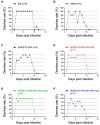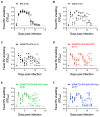Reverse Genetics of Murine Rotavirus: A Comparative Analysis of the Wild-Type and Cell-Culture-Adapted Murine Rotavirus VP4 in Replication and Virulence in Neonatal Mice
- PMID: 38793648
- PMCID: PMC11125933
- DOI: 10.3390/v16050767
Reverse Genetics of Murine Rotavirus: A Comparative Analysis of the Wild-Type and Cell-Culture-Adapted Murine Rotavirus VP4 in Replication and Virulence in Neonatal Mice
Abstract
Small-animal models and reverse genetics systems are powerful tools for investigating the molecular mechanisms underlying viral replication, virulence, and interaction with the host immune response in vivo. Rotavirus (RV) causes acute gastroenteritis in many young animals and infants worldwide. Murine RV replicates efficiently in the intestines of inoculated suckling pups, causing diarrhea, and spreads efficiently to uninoculated littermates. Because RVs derived from human and other non-mouse animal species do not replicate efficiently in mice, murine RVs are uniquely useful in probing the viral and host determinants of efficient replication and pathogenesis in a species-matched mouse model. Previously, we established an optimized reverse genetics protocol for RV and successfully generated a murine-like RV rD6/2-2g strain that replicates well in both cultured cell lines and in the intestines of inoculated pups. However, rD6/2-2g possesses three out of eleven gene segments derived from simian RV strains, and these three heterologous segments may attenuate viral pathogenicity in vivo. Here, we rescued the first recombinant RV with all 11 gene segments of murine RV origin. Using this virus as a genetic background, we generated a panel of recombinant murine RVs with either N-terminal VP8* or C-terminal VP5* regions chimerized between a cell-culture-adapted murine ETD strain and a non-tissue-culture-adapted murine EW strain and compared the diarrhea rate and fecal RV shedding in pups. The recombinant viruses with VP5* domains derived from the murine EW strain showed slightly more fecal shedding than those with VP5* domains from the ETD strain. The newly characterized full-genome murine RV will be a useful tool for dissecting virus-host interactions and for studying the mechanism of pathogenesis in neonatal mice.
Keywords: reverse genetics; rotavirus; small-animal model.
Conflict of interest statement
The authors declare no conflicts of interest in this project.
Figures



Similar articles
-
A rotavirus VP4 or VP7 monoreassortant panel identifies genotypes that are less susceptible to neutralization by systemic antibodies induced by vaccination or natural infection.mBio. 2025 Jul 9;16(7):e0089725. doi: 10.1128/mbio.00897-25. Epub 2025 May 30. mBio. 2025. PMID: 40444468 Free PMC article.
-
The Role of the VP4 Attachment Protein in Rotavirus Host Range Restriction in an In Vivo Suckling Mouse Model.J Virol. 2022 Aug 10;96(15):e0055022. doi: 10.1128/jvi.00550-22. Epub 2022 Jul 12. J Virol. 2022. PMID: 35862708 Free PMC article.
-
Rotavirus NSP1 Contributes to Intestinal Viral Replication, Pathogenesis, and Transmission.mBio. 2021 Dec 21;12(6):e0320821. doi: 10.1128/mBio.03208-21. Epub 2021 Dec 14. mBio. 2021. PMID: 34903043 Free PMC article.
-
The role and implication of rotavirus VP8∗ in viral infection and vaccine development.Virology. 2025 Aug;609:110563. doi: 10.1016/j.virol.2025.110563. Epub 2025 May 8. Virology. 2025. PMID: 40378555 Review.
-
Genetic Profile of Rotavirus Type A in Children under 5 Years Old in Africa: A Systematic Review of Prevalence.Viruses. 2024 Feb 3;16(2):243. doi: 10.3390/v16020243. Viruses. 2024. PMID: 38400019 Free PMC article.
Cited by
-
Rotaviruses and Rotavirus Vaccines: Special Issue Editorial.Viruses. 2024 Oct 24;16(11):1665. doi: 10.3390/v16111665. Viruses. 2024. PMID: 39599780 Free PMC article.
-
Innate immune sensing of rotavirus by intestinal epithelial cells leads to diarrhea.Cell Host Microbe. 2025 Mar 12;33(3):408-419.e8. doi: 10.1016/j.chom.2025.02.005. Epub 2025 Mar 3. Cell Host Microbe. 2025. PMID: 40037352
-
A rotavirus VP4 or VP7 monoreassortant panel identifies genotypes that are less susceptible to neutralization by systemic antibodies induced by vaccination or natural infection.mBio. 2025 Jul 9;16(7):e0089725. doi: 10.1128/mbio.00897-25. Epub 2025 May 30. mBio. 2025. PMID: 40444468 Free PMC article.
-
Establishment of a reverse genetics system for an epidemic strain of porcine rotavirus JXAY01 type G5P[23]I12.Front Vet Sci. 2025 Feb 12;11:1512327. doi: 10.3389/fvets.2024.1512327. eCollection 2024. Front Vet Sci. 2025. PMID: 40012614 Free PMC article.
-
Novel murine model of human astrovirus infection reveals cardiovascular tropism .J Virol. 2025 May 20;99(5):e0024025. doi: 10.1128/jvi.00240-25. Epub 2025 Apr 30. J Virol. 2025. PMID: 40304490 Free PMC article.
References
-
- Crawford S.E., Ding S., Greenberg H.B., Estes M.K. Fields Virology. 7th ed. Volume 3. Lippincott Williams & Wilkins; Philadelphia, PA, USA: 2022. Rotaviruses; pp. 362–413.
Publication types
MeSH terms
Substances
Grants and funding
LinkOut - more resources
Full Text Sources
Medical

